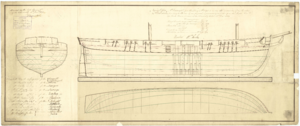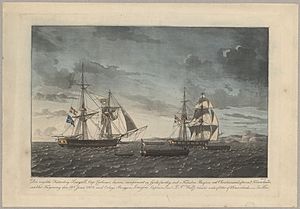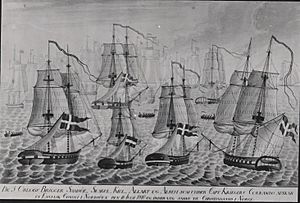HMS Seagull (1805) facts for kids

Drawing showing the body plan with stern board outline, sheer lines with midship framing and scroll figurehead, and longitudinal half-breadth for the Seagull
|
|
Quick facts for kids History |
|
|---|---|
| Name | HMS Seagull or Sea Gull |
| Ordered | 12 December 1804 |
| Builder | John King, Dover |
| Laid down | January 1803 |
| Launched | 1 July 1805 |
| Captured | 19 June 1808 |
| Name | The Seagull |
| Acquired | 19 June 1808 (by capture) |
| Fate | Transferred to Norway 1814 |
| Name | Seagull |
| Acquired | 1814 (by transfer) |
| Decommissioned | 1817 |
| General characteristics | |
| Type | Seagull-class brig-sloop |
| Tons burthen | 284 86⁄94 (bm) |
| Length |
|
| Beam | 26 ft 6 in (8.1 m) |
| Depth of hold | 12 ft 0 in (3.7 m) |
| Sail plan | Brig |
| Complement | 95 |
| Armament |
|
HMS Seagull (or Sea Gull) was a special ship called HMS Seagull. It was the first ship in its group, known as the Seagull-class brig-sloops, built for the Royal Navy (the British navy). It was launched on July 1, 1805. It served the British in waters near Denmark. On June 19, 1808, forces from Denmark and Norway sank it. But the Danes pulled the ship up and fixed it. It then joined the Dano-Norwegian Navy until 1814, when the wars ended. After that, it became part of the Norwegian navy. The ship was finally taken out of service in 1817.
Contents
The HMS Seagull started its service in August 1805. Its first commander was Robert Cathcart.
In April 1806, the Seagull captured a Prussian ship called a galiot. It sent this ship to the Downs, a safe place for ships.
The Seagull was very busy in 1807 in the North Sea. It helped capture several ships, either alone or with other British ships. These ships included the Venus, Resolution, Aurora, Gabriel, Karen and Amalia, Emanuel, Dolphin, Haabet Ankes, and Fly.
The Seagull also rescued two ships that had been captured by enemies. These were the Jane and the transport brig Elizabeth. The Elizabeth had been taken by three privateer ships. The Seagull brought it safely to Dover.
Finally, in August 1807, the Seagull found a ship called Dove drifting by itself near France. The Dove was from Weymouth and was carrying a cargo of stone. The Seagull brought it to the Downs.
The Seagull is Captured
On June 19, 1808, the Seagull was near the Naze of Norway, close to the port of Kristiansand. It was chasing a Dano-Norwegian ship called Lougen. The Lougen had 18 short 18-pounder guns and two long 6-pounder guns. The Lougens commander, Lieutenant Peter Frederik Wulff, tried to keep his distance. This was because his 18-pounder guns could shoot farther than the Seagulls 24-pounder carronades.
The chase led both ships very close to the shore, where the wind became very light. The Seagull tried to get between the Lougen and the shore. This would stop the Danish ship from reaching Kristiansand.
However, about 20 minutes into the fight, six Danish gunboats appeared. They came from behind some rocks. These gunboats took positions on the Seagull's side and fired their 24-pounder guns. At the same time, the Lougen fired at the Seagulls front-left side. Within half an hour, the Danish attack had badly damaged the Seagulls ropes and sails. Five of its guns were also knocked out of place.
Eventually, Commander Cathcart, who was badly hurt, gave up the fight. Eight of his men were killed, and 20 were wounded. Vice-Admiral Thomas Wells later said that such bravery should be known to everyone. The Lougen only had one man killed and about twelve men slightly wounded.
The Danes held Commander Cathcart as a prisoner until October 1808. In November, he and his crew were put on trial for losing their ship. But the court decided they were innocent and brave. Commander Cathcart was even promoted to a higher rank, called post-captain. His first officer, Villiers Francis Hatton, was also promoted. Cathcart then took command of another ship, Ganymede, and the surviving crew from the Seagull joined him.
Soon after the battle, Lieutenant Wulff of the Lougen was also promoted. He became a knight in Denmark.
After the battle, the Danes removed the crew from the Seagull, including the dead and wounded. They sent teams to try and fix the damage. However, the Seagull had more than five feet of water inside. It suddenly sank, and several Danes drowned. Lieutenant Wigelsen, who was second in command of the Lougen, took charge of the captured ship. He wrote in his diary:
I took command of the prize. She had taken a great many direct hits in the bows as well as the side. So many hits that the holes were large and irregular and could not be plugged by normal methods. When I came on board the water was already over the lower decks and was rising fast. I managed to get the ship into harbour, however, and run aground. A little past midnight, she capsized and I had to escape by swimming. Happily, we later managed to raise the brig and she was used to good effect in the war.
—Broder Knud Brodersen Wigelsen
Even though it sank, the Seagull was in shallow water in Fosseholmen Bay, near Kristiansand. Part of the ship stayed above the water. The Danes were able to pull it up later and fix it. It then joined the Dano-Norwegian Navy. Its new commander was Lieutenant O. Kr. Budde.
On November 25, 1808, this ship, now called The Seagull by the Danes, fought and captured a Swedish gunboat named Gripen. The Seagull was operating from Kristiansand. The Gripen had nine guns and a crew of 40 men.
On May 12, 1810, The Seagull was part of a fight against the British ship Tribune. This happened near Mandal. Four Danish ships and several gunboats attacked the Tribune. The Tribune lost nine men and had 15 wounded before the Danish ships went back to Mandal.
In 1812, after a battle called the Battle of Lyngør, a British ship checked on Danish warships. It reported that The Seagull, with 16 guns and 100 men, was at Kristiansand. The British thought the Danes would not be able to do anything important that summer.
By 1813, The Seagull was commanded by Kapteinløitnant C. Lütken. In December, Seagull, Lolland, and Samsøe sailed to Frederickshavn in Jutland. Their mission was to protect a group of ships carrying much-needed grain to Norway. They succeeded, even though one grain ship was captured by a Swedish privateer.
When the wars between Britain and Denmark ended, Norway separated from Denmark. The Seagull, which was based in Kristiansand, became part of the Royal Norwegian Navy. It was taken out of service in 1817.



